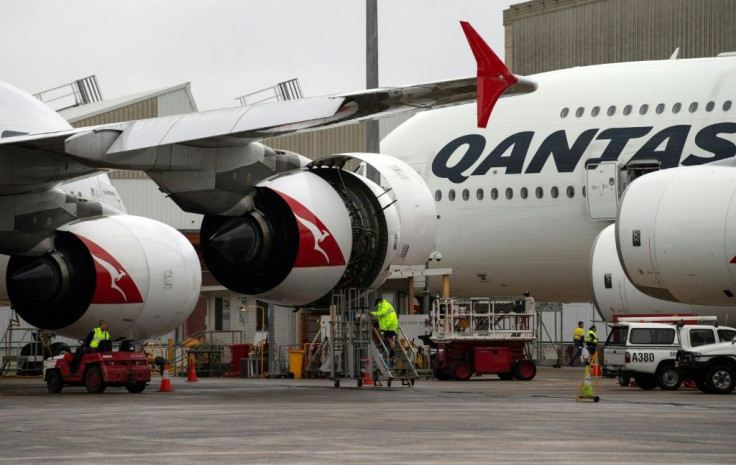Coronavirus Update: Airlines Reeling From Halted Service To And From China

KEY POINTS
- Mainland China flights accounted for 5.5% of Air France-KLM’s 2019 traffic
- Qantas cancelled all flights to mainland China through the end of March
- Private jet carriers seeing a surge in requests for flights to and from China
The coronavirus epidemic will hurt the bottom line of some airlines due to weakened demand for travel to China and East Asia.
Australia's Qantas Airways said the outbreak will cost the airline up to $99 million through the year ending on June 30, while Air France-KLM estimated it will incur a financial loss of up to $216 million between February and April.
Air France-KLM has extended its ban on flights to China through the end of March, while Qantas will reduce flights to Asia by 15% through the end of May.
“That’s the hypothesis we’re using for the moment, but we don’t know how credible it is,” said Air France-KLM Chief Financial Officer Frederic Gagey. “Obviously if [the delay] lasts longer, the impact will be heavier.”
Mainland China flights accounted for 5.5% of Air France-KLM’s 2019 traffic.
Qantas has suspended flights between Sydney to Shanghai, reduced its capacity to Hong Kong and ended its Sydney-to-Beijing route earlier than expected after the Australian government slapped restrictions on travelers from mainland China.
On Thursday Qantas said it cancelled all flights to mainland China through the end of March.
"Coronavirus resulted in the suspension of our flights to mainland China and we're now seeing some secondary impacts with weaker demand on Hong Kong, Singapore and to a lesser extent Japan,” said Qantas chief executive Alan Joyce. "We've also seen some domestic demand weakness emerging, so we're adjusting Qantas and Jetstar's capacity in the second half [of the year].”
Jetstar is a low-cost wholly owned subsidiary of Qantas
Qantas also said that will freeze hiring in the meantime and requested employees use their vacations now. The airline estimated that with all the planned cuts in flights, it has a surplus of about 700 workers.
"We have [a total of] 30,000 employees across the group," Joyce said. "The way we'll manage it is to ask across the 30,000 people, for people to take annual leave, long-service leave and use their leave balances, which are quite considerable. What's important is that we have flexibility in how we respond to coronavirus and how we maintain our strategic position more broadly. We can extend how long the cuts are in place, we can deepen them or we can add seats back in if the demand is there."
In China itself, the government of Hainan province is planning to take control of indebted conglomerate HNA Group and sell off its airline assets as it struggles financially.
HNA directly controls or holds stakes in a number of carriers, including Hainan Airlines.
Bloomberg reported that under the current plan, the government will sell most of HNA’s airline assets to China’s three biggest carriers: Air China Ltd., China Southern Airlines Co. and China Eastern Airlines Corp.
“HNA is, even by Chinese standards, a sprawling and indebted conglomerate, and the collapse in Chinese airline activity due to the outbreak of [coronavirus] has apparently pushed it to effective bankruptcy,” Agency Partners analysts led by Nick Cunningham wrote.
Meanwhile, as the virus worsens its grip on China and reduces air traffic there, private air carriers are witnessing an increase in activity. However, many of these high-priced firms cannot meet demands of prospective customers due to travel bans and a lack of available aircraft.
"Many [private carriers] simply do not want to send their aircraft and crews into mainland China,” said Darin Voyles, vice president of charter sales at Paramount Business Jets in Australia. “Aside from the risk of exposure for the crews, the operational and business concern is that when they return from mainland China they will essentially be unable to work for two weeks as they will have to go into quarantine immediately.''
A ''very light jet'' can carry between two and four passengers and cost up to $2,400 per hour according to Paramount Business Jets. A "super midsize" jet can hold between eight and 10 people and costs $6,000 per hour.
MyJet Asia of Singapore has witnessed an increase of 80%-90% in flight requests over the last month.
"A lot of people went away for Chinese New Year and are now struggling to get back to China," said Logan Ravishkansar, chief executive of MyJet Asia. "But we are massively restricted on where we can fly to, while the airlines are not letting us charter their planes despite the money.”
Malta-based global private jet firm VistaJet said it has seen a flurry of inquiries for its services over the past month even though it has ceased service to and from China.
"While a large portion of the increase can be related to Chinese New Year travel, we also attribute the growth to customers preferring a private flight rather than a commercial option during a delicate time affected by the coronavirus outbreak," said Ian Moore, chief commercial officer of VistaJet.
© Copyright IBTimes 2024. All rights reserved.





















